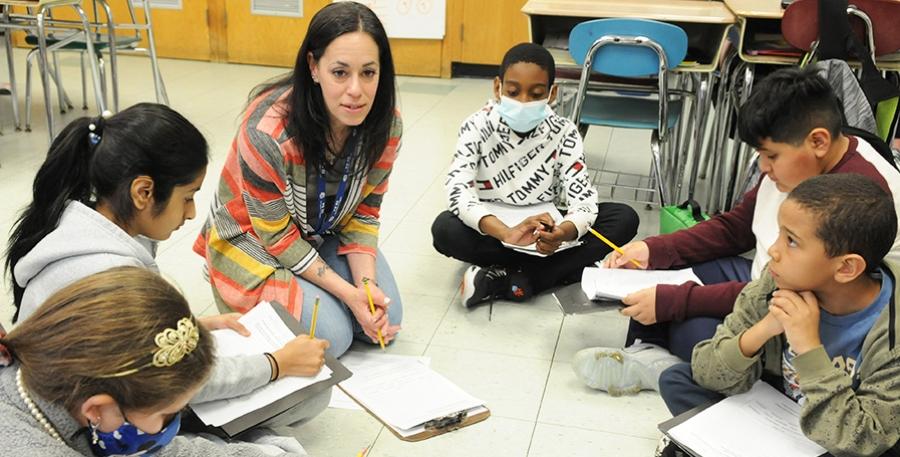
Practicing purposeful, flexible and skills-based grouping, like this teacher at PS 22 on Staten Island, is one way to address students’ differing needs.
On an anonymous online message board for New York City teachers, a high school ELA teacher recently posed a question: If some of my students are new to the country and just learning to read English, some read at a 5th-grade level and some are at or above grade level, how do I differentiate instruction for all of them?
It’s an age-old question for many New York City public school teachers that has become more pressing in the wake of pandemic-aggravated inequalities.
New York City students’ scores declined 7.6 percentage points in math this year from 2019, according to state test results released by the city Department of Education in September. Younger students struggled more than older ones to keep pace. Teachers like Stephanie Cullaj, a UFT Teacher Center site coordinator at PS 536 in Parkchester, the Bronx, have experienced that drop as part of a widening gulf between struggling students and high achievers.
“We’ve noticed, especially in math, there are quite a few students well below grade level and a chunk above grade level,” she says. “Differentiating is a struggle.”
What can educators do to address a particularly wide range of abilities in their classrooms? Here are a few places to start:
Examine standards and data to target specific learning goals. At PS 1 in Tottenville on Staten Island, educators from all grades pored over the Next Generation Learning Standards to “see the flow of how it goes from one grade to the next,” says UFT Teacher Center site coordinator Marianne Shenton. “It’s a blueprint of where they’ve been and where you’re going.”
Reviewing the standards can help you pinpoint the skills your students lack, and looking ahead to higher grades will help you prioritize the skills you should focus on. In math, for example, multiplication unlocks a host of other functions that students need to master in the upper grades — like fractions, ratios and proportions. Students who struggle with multiplication after 3rd grade likely need to focus on this crucial skill before they are ready to tackle higher-level work.
Assessment data that measure students’ grade-level ability without designating specific skills for improvement won’t be helpful. Think of this data as “academic triage”: What do you need to address right away for students to begin to be successful? What skills will you continue to rehabilitate throughout the year?
Practice purposeful, flexible and skills-based grouping. Grouping students by ability level is one obvious way to address their differing needs, but it isn’t the only way.
“If I’m doing guided reading, I do want to meet with students who are all on the same reading level. But we don’t always want struggling readers to be with other struggling readers,” says Cullaj.
Be thoughtful about trying to pair students in ways that address the specific skills and standards they need to work on across subjects, not only their overall ability. When I taught 3rd grade, some of my most-advanced readers were also enthusiastic writers. They could produce volumes in one writing workshop period, but they were less adept at revising and editing their work. When they were paired up with students who were reading below grade level, both sets of students benefited: The struggling readers got the opportunity to read authentic material written by their peers, and their feedback helped the prolific writers review their own work.
If you think back to your own school experience in classes where students were grouped by academic level, it’s likely that even today — whether the groups were named after shapes, colors or something else — you remember if you were in the “high” group or the “low” group. To avoid that stigmatization, try to devise other kinds of cross-curricular groups that highlight only students’ strengths. Some students seem to have an uncanny ability to keep tabs on your classroom schedule — they can be your timekeepers. Artistic students can design your classroom bulletin boards. Teaching students to draw on their nonacademic talents will make their learning more authentic.
When possible, pre-teach in addition to reteaching. When students are struggling with a concept or skill, it’s common for teachers to pull them into a small group or meet with them individually after a lesson, unit or assessment to support them.
But when students are far below grade level, they may lack some of the foundational skills they need for the lesson itself. When you’re planning a lesson, Cullaj suggests, “Determine what one to two prerequisite skills are absolutely necessary to meet the lesson objective and find a way to pre-teach them if possible.”
Pre-teaching doesn’t always mean drafting a whole new lesson. Previewing vocabulary in advance of a lesson, for instance, can be especially helpful for English language learners.
If you find yourself overwhelmed with the challenge of reaching every student where they are, remember you’re not alone. Administrators, coaches and intervention specialists are there to work with you to help students who need the most academic support.